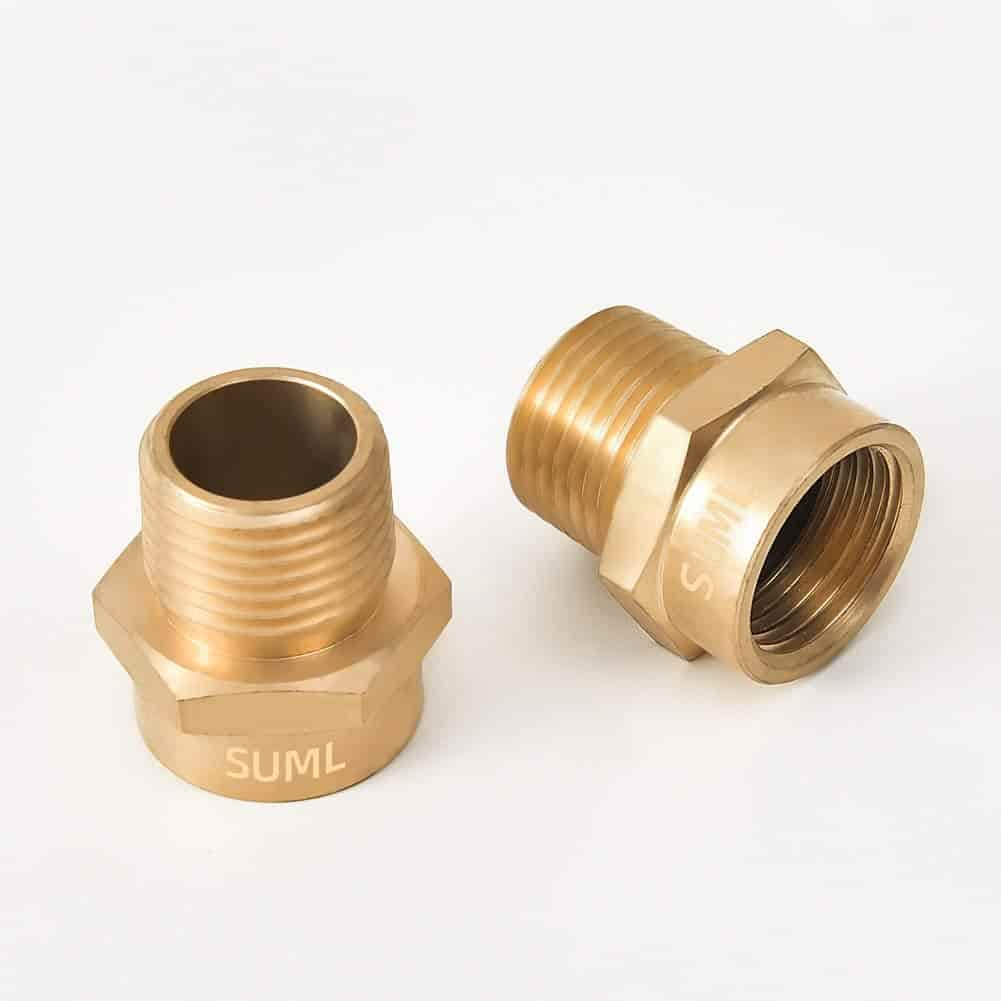BSP (British Standard Pipe) and NPT (National Pipe Taper) are popular thread types worldwide. Both are pretty handy when you are doing your fitting task. But today, we will compare NPT vs BSP Threads.
When searching for the difference, you may not find the exact difference between them. But one thing that makes these threads unique is their brand and the production country. NPT are generally produced in the USA and Canada. On the other hand, the UK, Australia, and other commonwealth countries have BSP threads.
Both are superior in case of functionality. You just have to choose one according to the pressure you want to apply.
A Quick Comparison: NPT vs BSP thread chart
| Basis of Comparison | NPT Thread | BSP Thread |
| Acronym | National Pipe Taper | British Standard Pipe |
| Thread Types | Male and Female | BSPP and BSPT |
| Availability | Mostly used in USA and Canada | Mostly used in Australia and other Commonwealth countries |
| Connection Type | Internal and external thread connection | Parallel or straight connection and tapered connection |
| Price | 1.5$ – 3.0$ per item | 5$ – 7$ per item |
| Material | Brass, Plastics, or Copper | Brass or Copper |
| Temperature Tolerance | 30°F to 150°F | -60°F – 250°F |
| Pressure resistance | Up to 150 PSI | Up to 250 PSI |
| Dimension | 1/2″, 3/4″ etc. | 1/4″, 3/8″ etc. |
| Thread angle | 60-degree angle | 55-degree angle |
What is NPT Thread?
NPT (National Pipe Taper) is also famous as ANSI / ASME B1.20.1 Pipe Thread. This is the American standard for grading tapered threads in pipes and threaded fittings. Also, the NPT thread angle is 60°.
NPT threads are sometimes called Male Pipe Thread (MPT) and are not replaceable with National Pipe Straight (NPS) thread. Unlike straight bolt threads, tapered threads tighten, creating a tighter seal.
Pros:
- They are always available.
- Easy to install without piping expansion, bushings, gaskets, or O-rings.
- You may find it in different shapes, combinations, sizes, and materials.
- It is famous worldwide.
Cons:
- You can not use them where you have to withstand high pressure.
What is BSP Thread?
BSP or British Standard Pipe is the name of technical standards set that define specific threads. Most countries worldwide have adopted and are using these standards for joining and sealing fittings and pipes.
You have to understand the female and male parts to use these threads ideally. The male threads are external, and the female threads are internal. To glue the 2 pieces together, you must screw the outer mold tightly into the inner mold.
Pros:
- They can withstand high pressure up to 250 PSI.
- These threads are more durable than plastic material.
- They are rust-resistant.
- These threads ensure no leakage during operation.
Cons:
- The screws sometimes seem a bit thicker
NPT vs BSP Threads: Detailed key Differences
Thread Types:
NPT has female and male tapered threads sealed with flange or Teflon tape. You can find them in the following types for NPT:
- Male Pipe Thread (MPT)
- Female Pipe Thread (FPT)
- Female Iron Pipe (FIP)
- Male Iron Pipe (MIP)
- Iron Pipe Thread (IPT)
On the other hand, BSP threads have two popular types. And they are:
- BSPT (British Standard Pipe Taper)
- BSPP (British Standard Pipe Parallel)
Availability:
NPT threads are mostly found in the USA and Canada. On the other hand, BSP threads are available in the UK, Australian and other European and commonwealth countries.
Durability:
NPT thread contains brass, copper or plastic and BSP threads contain brass or copper. Brass is more durable than plastic. And thus, BSP threads are more long lasting.
Pressure Resistance:
BSP has more pressure resistance than the NPT threads. BSP threads can tolerate up to 250 PSI, whereas NPT threads can tolerate about 150 PSI.
See More: hose thread vs pipe thread
BSP & NPT Thread Dimensions Table
BSP and NPT thread have a different diameter for different types of connection. Let’s find some available sizes, including Threads Per Inch or TPI and Outside Diameter or OD for both BSP and NPT thread.
| BSP (1/8 inch to 2 inches)Threads | ||
| Size of Thread (inch) | PTI (Threads Per Inch) | Outside Diameter (OD) (Inches) |
| 1/8 | 28.0 | 0.383 |
| 1/4 | 19.0 | 0.518 |
| 3/8 | 19.0 | 0.656 |
| 1/2 | 14.0 | 0.825 |
| 3/4 | 14.0 | 1.041 |
| 1 | 11.0 | 1.309 |
| 1 to 1/4 | 11.0 | 1.650 |
| 1 to 1/2 | 11.0 | 1.882 |
| 2 | 11.0 | 2.347 |
| NPT (1/8 inch to 2 inches) Threads | ||
| Size of Thread (inch) | PTI (Threads Per Inch) | Outside Diameter (OD) (Inches) |
| 1/8 | 27.0 | 0.405” |
| 1/4 | 18.0 | 0.540 |
| 3/8 | 18.0 | 0.675 |
| 1/2 | 14.0 | 0.840 |
| 3/4 | 14.0 | 1.050 |
| 1 | 11.5 | 1.315 |
| 1-1/4 | 11.5 | 1.660 |
| 1-1/2 | 11.5 | 1.900 |
| 2 | 11.5 | 2.375 |
Can I use BSP and NPT Thread altogether?
Because of the variations in their thread forms, NPT and BSP threads are usually incompatible. The peaks and valleys of NPT threads are flattened and have a 60° included angle. BSP threads, on the other hand, feature rounded peaks and valleys with a 55-degree included angle.
To use NPT and BSP threads together, the BSP to NPT thread adapter comes into play. You can find some compatible adapters in the market. Besides, you can design some custom thread models in the SolidWorks NPT thread design tool to solve your specific fitting problem.
How to Measure NPT Thread Size?
When measuring the NPT threads size, you have to subtract 1/4 inch from the original size. The wall thickness of the hose depends on the hose size.
For example, to determine 1/4 inch external pipe threads, measure the outside of the threads. Then deduct 1/4 inch from the outer diameter measurement for pipe wall thickness from one of the two sides. When determining internal pipe threads, measure the pipe’s outside diameter and subtract ¼” to get the correct thread size.
It may be even more comfortable to buy a vernier caliper measuring tool that measures the outer and inner diameter (ID). You can follow the table as mentioned earlier to measure the thread size.
Best NPT Thread
- TAILONZ PNEUMATIC Male Straight NPT Thread
The materials used to make this pneumatic NPT thread are high-quality pure copper and plastic. Its shining surface and polished fitting edge provide the greatest possible connection. It can spin 360 degrees, giving you more versatility throughout the installation procedure.
It has an outer diameter (OD) of 1/4″ and 1/8″ and a thick interface that provides extraordinary pressure resistance and anti-explosion features. This thread also includes sealing the glue for connections that do not need the use of Teflon tape.
- TAILONZ PNEUMATIC Male Elbow NPT Thread
For your fitting connections, this male elbow-shaped NPT thread offers outstanding flexibility and durability. It features an outer diameter (OD) of 1/4 inch by 1/4 inch and excellent pressure and temperature resistance.
This thread can withstand a maximum pressure of 145 PSI and a maximum temperature of 140°F. It also features a 360° rotating angle, which is an excellent advantage for the installation procedure. Its substantial outer surface ensures a long service life and resistance to pressure and explosion.
Best BSP Thread
- GESHATEN G Thread (BSP)
This BSP to NPT connector comes with a size of 1/2 inch BSP female to 1//2 inch NPT male to solve the connection problem between two different thread types.
This threaded connector is made of the highest quality brass material, giving it a long lifespan, rust resistance, and the ability to withstand a great deal of pressure. Furthermore, a rubber washer is included in this connection to prevent leaking.
- HongBoW BSPT Male Female Brass Pipe Fitting
For your pipe fitting work, this package comprises BSPT Male Thread and NPT Female Thread.
This thread is constructed of Brass, which provides corrosion resistance and flexibility at high temperatures.
Moreover, these threads can function in temperatures ranging from -65 to 250 degrees Fahrenheit, which is a significant advancement. The male thread diameter is 9.73mm, while the female thread diameter is 11.9mm.
Video Explanation: NPT and BSP Threads
Final Verdict:
I hope our comparison of NPT vs BSP Threads will help you purchase the right product for your needs. The most crucial thing to remember is that no NPT or BSP thread is superior to the others.
Despite the two distinct designs, each thread performs well. The distinction is primarily determined by the threads’ kind of application and where they are used.
It is not a good idea to utilize the NPT and BSP threads together. Choose either an NPT or a BSP thread for your connection to guarantee reliability and uniformity. When it comes to new projects, choose the most available one in your area and it is a suitable match for your job.





